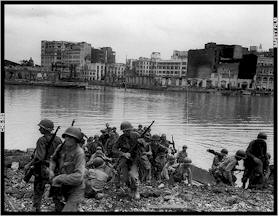Troops of the 3d Battalion, 129th Infantry, had begun
loading aboard assault boats manned by the 117th Engineers about 0820 on 23
February, their line of departure the mouth of the Estero de Binondo,
opposite the Government Mint.14 (Map
7) The first boats reached the south shore unopposed between 0835 and
0840, and the infantry quickly dashed through and by the Mint into
Intramuros. Putting its left on Beaterio Street, which ran northeast to
southwest, the 3d Battalion swung its right toward Fort Santiago, at the
northwest corner of Intramuros. The battalion established contact with the
145th Infantry about 0850 at Letran University, at the northeast corner.
As the American troops drove further into Intramuros, the
Japanese began to recover from the shock of the artillery bombardment and to
offer scattered resistance from isolated machine gun and rifle positions.
Company I, 129th Infantry, on the left, and Company L, in the center,
reached the west wall shortly after 1200, having suffered no casualties and
having killed only 10 Japanese on the way. The battalion soon isolated
resistance in its sector to Fort Santiago, toward which Company L, attacking
along the west wall and through adjacent buildings, turned. Company K had
some difficulty reaching the west wall in the area south of Fort Santiago
but got its right on the wall to make contact with Companies I and L late in
the day. In concert, the three rifle companies cleared the west wall north
from Beaterio Street. About 1830 Company K
made contact with elements of the 1st Cavalry Brigade in the South Port
Area, beyond the west wall.
Company L had a nasty fight on its hands at Fort
Santiago. The preassault artillery bombardment had demolished the outlying
defenses of this ancient Spanish citadel and had also battered the walls of
the fort proper. The Japanese inside had retired into inner recesses, a few
undamaged outbuildings, some subterranean dungeons, tunnels, and holes. One
by one, the 129th Infantry reduced the separate strongpoints--no
co-ordinated defense existed--with fragmentation and white phosphorus
grenades, demolitions, bazookas, and flame throwers. In a few instances
engineers poured gasoline or oil into holes and dungeons and then ignited
it. Company L had actually surrounded and entered the fort quickly, but
faced a bitter battle throughout the afternoon and had to leave mopping up
for the morrow.
The 145th Infantry's experiences during the day were not
dissimilar. Clambering across the breach south of Quezon Gate and then
through the gate itself, the two leading platoons of the 2d Battalion,
145th, were within Intramuros at 0833 without a casualty. Following troops
walked through Quezon and Parian Gates unopposed, and by 1030 the battalion
had secured the first two blocks southwest of Quezon Gate and had cleared
the damaged building of Letran University. Fifteen minutes later the 1st
Battalion came through Parian Gate. The two units then started southward
with the 2d Battalion's right on Beaterio Street, in contact with the 129th
Infantry, and the 1st Battalion's left along the east wall.
Progress slowed as troops sought cover from automatic
weapons and rifle fire originating in the southern section of Intramuros. At
1300 the two battalions were four blocks southwest of Quezon Gate and had
established a line stretching from Beaterio almost to the east wall. At this
juncture the advance stopped as the Japanese began letting nearly 3,000
civilian hostages dribble out of San Augustin and Del Monico Churches,
farther south. The refugees were women, children, and some Roman Catholic
nuns and priests. There were very few male civilians in the group--the 129th
Infantry had discovered most of the men dead in Fort Santiago's dungeons,
where the Japanese had murdered them.15
After the civilian evacuation was complete, American
tanks and self-propelled mounts fired on Japanese positions within the two
churches and at other strongpoints in the southwestern section of Intramuros,
including a few pillboxes. Against stubborn opposition, troops of the 145th
Infantry were unable to reach the south or west walls before dark, and the
two battalions halted for the night generally two blocks short of the west
wall and four short of the southwest corner of Intramuros.
The casualties of the 145th Infantry's two battalions for
23 February numbered about 15 men killed and 45 wounded; the regiment had
killed some 190 Japanese and captured 20 Formosan labor troops.16


